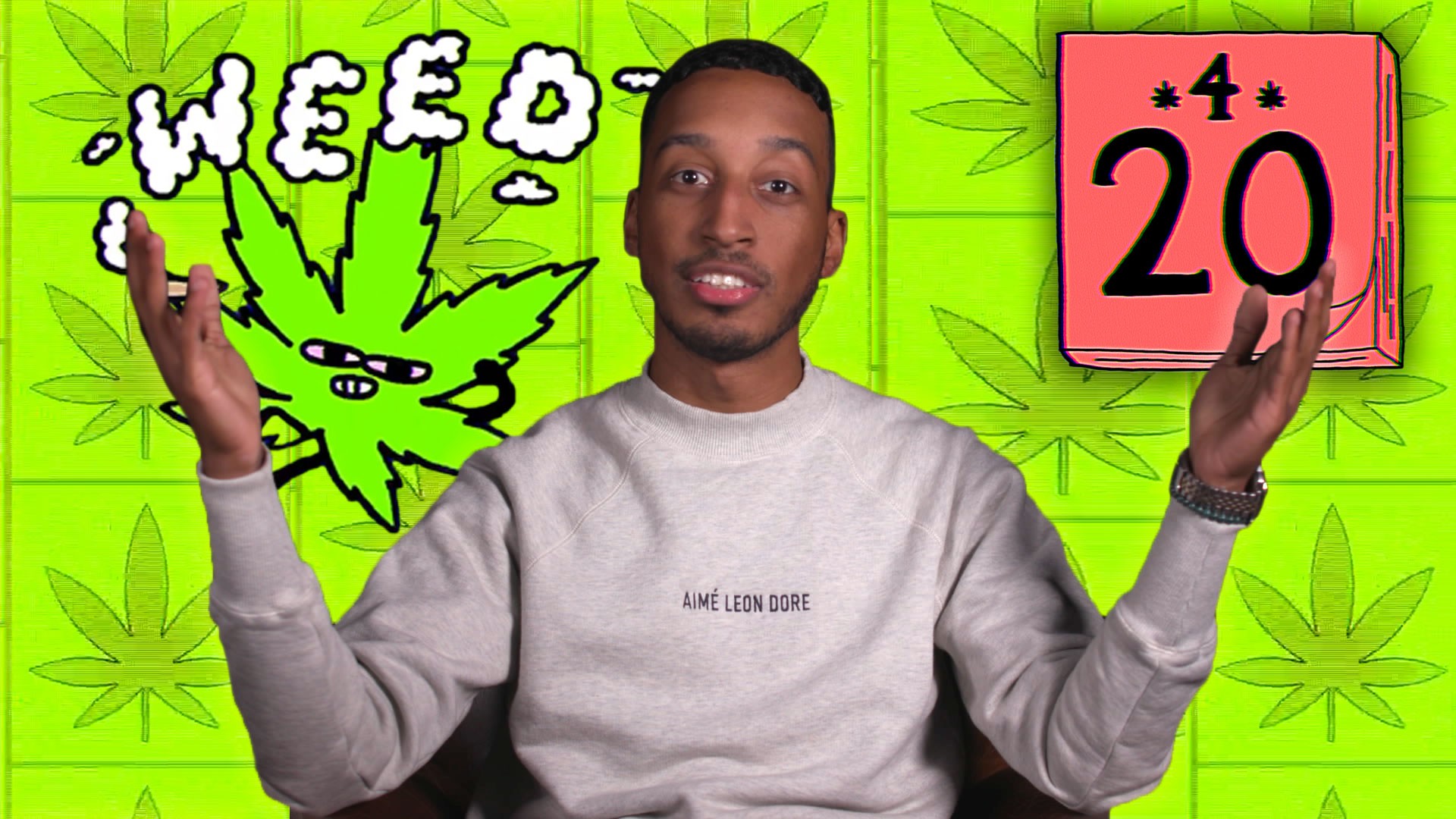Illustration by Cathryn Virginia | Photo via Shutterstock
High Wire is Maia Szalavitz's reported opinion column on drugs and drug policy.The headline might have seemed a bit ominous."A More Potent Marijuana Is Stirring Fresh Debates." Certainly, the story didn't disappoint: "Most marijuana now being sold throughout the United States is three to 10 times more potent than the marijuana that was sold two years ago," the New York Times wrote.It was 1978, Jimmy Carter was president, and weed legalization, at least for a moment, seemed possible.

By 1995, politics and culture had changed radically, and the war on drugs was inescapable. That year, Bill Clinton’s drug czar Lee Brown was making a similar—but even more explosive—claim. "Marijuana is 40 times more potent today… than 10, 15, 20 years ago."The following year, current Democratic presidential candidate and pot legalization foe Joe Biden argued that comparing 1990s weed to that from the 60s was like "comparing buckshot in a shotgun shell to a laser-guided missile." By 2002, a new drug czar, John Walters, was warning, "It is not your father's marijuana," and claiming a 30-fold recent increase in weed strength.In a recent thread on Twitter, Canadian author and weed advocate Dana Larsen tried to do the math based on a series of these claims, coming up with a figure suggesting that today's joints must be 12,600 times stronger than those smoked by the first stoners. Obviously, that's not the case.The truth about cannabis potency now and then is more complicated. Despite the political aims of the people hyping it, far from being a case for continued prohibition, stronger cannabis makes a far more potent argument for the drug's legalization and regulation. That's especially so at a time when THC, the primary psychoactive ingredient in weed, is being consumed in ways that—at least in the case of certain e-cigarettes or vapes—may be linked to dangerous lung problems.Of course, any argument that weed has become more potent (and, by implication, more dangerous) assumes we actually know how strong it was in decades past. But most of the hard numbers on changes in cannabis potency come from the government's Potency Monitoring Program, which has been run by the University of Mississippi since 1971 and is the only major lab focused on studying how it has changed historically. Their data relies on samples seized by law enforcement, which introduces variables that make accurate comparison over time—particularly in the early years—difficult.For one, the researchers only had access to about 150-200 samples per year in the early 1970s. With so few samples, the data could be based on unrepresentative ditchweed—not what most people were actually smoking. To wit, in yet another potency scare story, this one from 1986, the Times reported on data from the project finding that in 1974, the average percent of THC—the active ingredient that causes the high—was just .5 percent. That is basically a placebo. Indeed, it is legal now to sell hemp that contains just a tad less—.3 percent—because it is so difficult to get high on something with so little punch. Clearly, there was some sort of error.Mahmoud ElSohly, a professor of pharmaceutics at the University of Mississippi and director of the school's Marijuana Project—which oversees the Potency Monitoring Program—noted another problem that makes the old data less reliable. Before he took charge in 1981, the DEA often didn’t provide samples in a timely fashion, he said. "The samples were not sent to us until after the cases were disposed of legally," ElSohly explained, meaning they were often a few years old.Since potency decays by roughly 10 percent per year, according to ElSohly, this means that those samples didn't really represent the real strength of the drug at the time that people actually bought and consumed it. "The data you want to hang your hat on would start from 1981," he added.All of which is to say that any statements about "your father's weed" from the 1960s or 70s aren't likely based on reliable data.In later years, ElSohly continued, the Project began to receive 2,000 to 4,000 samples, which are much more likely to represent a reasonable survey of what's present in a national market. The more recent data does show a clear rise—from around 4 percent THC in 1995 to around 16 percent in 2018, according to ElSohly. However, since 2014, the number of samples tested has declined again, due to both funding issues and the DEA's decreased focus on seizing a drug that is legal in many states, he noted.Rising potency in and of itself isn't necessarily a problem, so long as people are aware of it. Just as the vast majority of people would never drink a giant beer glass full of whiskey or even wine the way they'd consume a shot of the hard stuff (you could actually overdose), those who use other drugs tend to titrate—or modulate based on the intensity of the substance—their consumption. This means that with stronger drugs, people tend to consume less in order to get exactly as high as they prefer.Fascinatingly, the government actually tracks how high people say they get from taking drugs. If titration weren't occurring, this data should show a rise that corresponds with the true increase of potency over time. But, in reality, pot smokers titrate: while there was an upward trend for some years in the 1990s, the proportion of high school seniors who blazed and said they got "very high" when they smoked pot is virtually the same as it was in 1975. The number for 1975 was 25.5 percent; for 2018, it was 25.4.A somewhat concerning change, however, has occurred in terms of the chemical content of weed. While THC produces the sensation of being high, another substance, CBD, can modulate its effect. CBD has been found to reduce the negative effects of THC, particularly in terms of its ability to produce paranoia and psychotic experiences—so much so that researchers have looked at CBD as a potential antipsychotic medication with far fewer side effects than current drugs.But between 1995 and 2014, the THC:CBD ratio went in the wrong direction, ElSohly and his colleagues found. Rather than having about 14 times more THC than CBD, today's street cannabis, on average, has 80 times more, the research showed.
Advertisement

By 1995, politics and culture had changed radically, and the war on drugs was inescapable. That year, Bill Clinton’s drug czar Lee Brown was making a similar—but even more explosive—claim. "Marijuana is 40 times more potent today… than 10, 15, 20 years ago."The following year, current Democratic presidential candidate and pot legalization foe Joe Biden argued that comparing 1990s weed to that from the 60s was like "comparing buckshot in a shotgun shell to a laser-guided missile." By 2002, a new drug czar, John Walters, was warning, "It is not your father's marijuana," and claiming a 30-fold recent increase in weed strength.In a recent thread on Twitter, Canadian author and weed advocate Dana Larsen tried to do the math based on a series of these claims, coming up with a figure suggesting that today's joints must be 12,600 times stronger than those smoked by the first stoners. Obviously, that's not the case.The truth about cannabis potency now and then is more complicated. Despite the political aims of the people hyping it, far from being a case for continued prohibition, stronger cannabis makes a far more potent argument for the drug's legalization and regulation. That's especially so at a time when THC, the primary psychoactive ingredient in weed, is being consumed in ways that—at least in the case of certain e-cigarettes or vapes—may be linked to dangerous lung problems.Of course, any argument that weed has become more potent (and, by implication, more dangerous) assumes we actually know how strong it was in decades past. But most of the hard numbers on changes in cannabis potency come from the government's Potency Monitoring Program, which has been run by the University of Mississippi since 1971 and is the only major lab focused on studying how it has changed historically. Their data relies on samples seized by law enforcement, which introduces variables that make accurate comparison over time—particularly in the early years—difficult.
Advertisement
Advertisement
Advertisement
None of this, however, can be addressed by keeping cannabis illegal—all of these changes occurred while that was already the case. A black market, by definition, is unregulated and changes in it occur without warning, or any sort of government approval process. We're seeing how problematic this can be not only with the deadly fentanyl crisis, but also in the horrifying cases of lung disease that now seem to be associated at least in some cases with illicit or counterfeit THC vape cartridges.In a legal market, however, higher potency products could be much more heavily regulated and restricted. Healthier ratios of THC to CBD could be mandated—or at the very least labeled. And consumer education could be provided about the effects of high THC/low CBD products. Appropriate warnings could be required on labels as well—particularly for people who may be at high risk of developing addictions or psychotic disorders due to family history, perhaps the most legit concern about strong weed there is."Higher THC strains are more likely to cause problems in people at risk for psychotic illness," said Dr. Julie Holland, a psychiatrist and editor of The Pot Book: A Complete Guide to Cannabis. Meanwhile, Dutch research suggests higher potency cannabis is linked with a higher rate of first time admissions to treatment for cannabis use disorder.Yet complete prohibition makes substances completely uncontrollable and leaves their sales and manufacture in the hands of people who are willing to break the law. If we want to reduce harm, we need more control over what’s in our weed—not less.Sign up for our newsletter to get the best of VICE delivered to your inbox daily.Follow Maia Szalavitz on Twitter.
